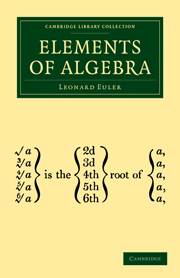Book contents
- Frontmatter
- ADVERTISEMENT
- MEMOIR OF THE LIFE AND CHARACTER OF EULER, BY THE LATE FRANCIS HORNER, ESQ., M. P.
- ADVERTISEMENT BY THE EDITORS OF THE ORIGINAL, IN GERMAN
- ADVERTISEMENT BY M. BERNOULLI, THE FRENCH TRANSLATOR
- Contents
- PART I Containing the Analysis of Determinate Quantities
- SECTION I Of the Different Methods of calculating Simple Quantities
- Chap. I OF Mathematics in general
- Chap. II Explanation of the signs + plus and − minus
- Chap. III Of the Multiplication of Simple Quantities
- Chap. IV Of the nature of whole Numbers, or Integers with respect to their Factors
- Chap. V Of the Division of Simple Quantities
- Chap. VI Of the properties of Integers, with respect to their Divisors
- Chap. VII Of Fractions in general
- Chap. VIII Of the Properties of Fractions
- Chap. IX Of the Addition and Subtraction of Fractions
- Chap. X Of the Multiplication and Division of Fractions
- Chap. XI Of Square Numbers
- Chap. XII Of Square Roots, and of Irrational Numbers resulting from them
- Chap. XIII Of Impossible, or Imaginary Quantities, which arise from the same source
- Chap. XIV Of Cubic Numbers
- Chap. XV Of Cube Roots, and of Irrational Numbers resulting from them
- Chap. XVI Of Powers in general
- Chap. XVII Of the Calculation of Powers
- Chap. XVIII Of Roots with relation to Powers in general
- Chap. XIX Of the Method of representing Irrational Numbers by Fractional Exponents
- Chap. XX Of the different Methods of Calculation, and of their Mutual Connexion
- Chap. XXI Of Logarithms in general
- Chap. XXII Of the Logarithmic Tables that are now in use
- Chap. XXIII Of the Method of expressing Logarithms
- SECTION II Of the different Methods of calculating Compound Quantities
- SECTION III Of Ratios and Proportions
- SECTION IV Of Algebraic Equations, and of the Resolution of those Equations
- PART II Containing the Analysis of Indeterminate Quantities
- ADDITIONS BY M. DE LA GRANGE
Chap. IV - Of the nature of whole Numbers, or Integers with respect to their Factors
Published online by Cambridge University Press: 05 July 2011
- Frontmatter
- ADVERTISEMENT
- MEMOIR OF THE LIFE AND CHARACTER OF EULER, BY THE LATE FRANCIS HORNER, ESQ., M. P.
- ADVERTISEMENT BY THE EDITORS OF THE ORIGINAL, IN GERMAN
- ADVERTISEMENT BY M. BERNOULLI, THE FRENCH TRANSLATOR
- Contents
- PART I Containing the Analysis of Determinate Quantities
- SECTION I Of the Different Methods of calculating Simple Quantities
- Chap. I OF Mathematics in general
- Chap. II Explanation of the signs + plus and − minus
- Chap. III Of the Multiplication of Simple Quantities
- Chap. IV Of the nature of whole Numbers, or Integers with respect to their Factors
- Chap. V Of the Division of Simple Quantities
- Chap. VI Of the properties of Integers, with respect to their Divisors
- Chap. VII Of Fractions in general
- Chap. VIII Of the Properties of Fractions
- Chap. IX Of the Addition and Subtraction of Fractions
- Chap. X Of the Multiplication and Division of Fractions
- Chap. XI Of Square Numbers
- Chap. XII Of Square Roots, and of Irrational Numbers resulting from them
- Chap. XIII Of Impossible, or Imaginary Quantities, which arise from the same source
- Chap. XIV Of Cubic Numbers
- Chap. XV Of Cube Roots, and of Irrational Numbers resulting from them
- Chap. XVI Of Powers in general
- Chap. XVII Of the Calculation of Powers
- Chap. XVIII Of Roots with relation to Powers in general
- Chap. XIX Of the Method of representing Irrational Numbers by Fractional Exponents
- Chap. XX Of the different Methods of Calculation, and of their Mutual Connexion
- Chap. XXI Of Logarithms in general
- Chap. XXII Of the Logarithmic Tables that are now in use
- Chap. XXIII Of the Method of expressing Logarithms
- SECTION II Of the different Methods of calculating Compound Quantities
- SECTION III Of Ratios and Proportions
- SECTION IV Of Algebraic Equations, and of the Resolution of those Equations
- PART II Containing the Analysis of Indeterminate Quantities
- ADDITIONS BY M. DE LA GRANGE
Summary
37. We have observed that a product is generated by the multiplication of two or more numbers together, and that these numbers are called factors. Thus, the numbers a, b, c, d, are the factors of the product abcd.
38. If, therefore, we consider all whole numbers as products of two or more numbers multiplied together, we shall soon find that some of them cannot result from such a multiplication, and consequently have not any factors; while others may be the products of two or more numbers multiplied together, and may consequently have two or more factors. Thus 4 is produced by 2 × 2; 6 by 2 × 3; 8 by 2 × 2 × 2; 27 by 3 × 3 × 3; and 10 by 2 × 5, &c.
39. But on the other hand, the numbers 2, 3, 5, 7, 11, 13, 17, &c. cannot be represented in the same manner by factors, unless for that purpose we make use of unity, and represent 2, for instance, by 1 × 2. But the numbers which are multiplied by 1 remaining the same, it is not proper to reckon unity as a factor.
All numbers, therefore, such as 2, 3, 5, 7, 11, 13, 17, &c. which cannot be represented by factors, are called simple, or prime numbers; whereas others, as 4, 6, 8, 9, 10, 12, 14, 15, 16, 18, &c. which may be represented by factors, are called composite numbers.
- Type
- Chapter
- Information
- Elements of Algebra , pp. 10 - 12Publisher: Cambridge University PressPrint publication year: 2009First published in: 1822

